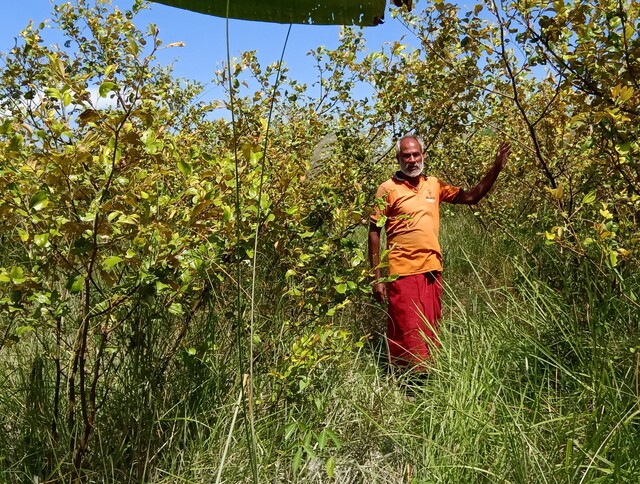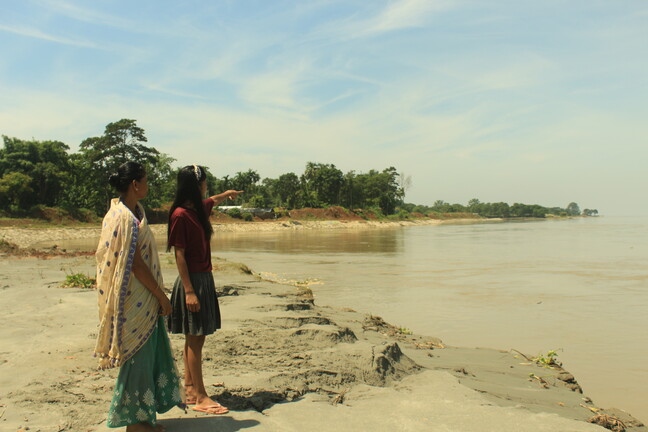Three years ago, when Ajbot Ali (62), a farmer and a father of four decided to develop a commercial horticulture nursery in Laheswari Char, his fellow farmers raised eyebrows. They were curious and empathetic to his efforts, yet puzzled, as developing a commercial horticulture nursery on a fragile char is not only unusual, but also involves serious risks. Now, however, Ali's experiment - growing Apple ber on fragile land of this char in the heart of the Brahmaputra - is a story they're more likely to share than their own.
Their apprehensions were genuine. Life in a char is always uncertain, as these isles are often prone to erosion, and like most farmers of his village, Ali, who loves to experiment on field, has a personal story of erosion and subsequent displacement. His family has had to shift ten times, each time moving further back from the river. There was a massive breach in one of the embankments in 2004, which forced him to move to a smaller plot of land, measuring only 1.5 katha (5 katha constitute a bigha) at some distance from the river. But the river has continued to erode its banks, and his new homestead land is now only about 500 meters from it.
With little hope of a livelihood from it, he has turned to growing different crops on around 40 bighas (7.5 bigha is a hectare) of land in Laheswari char. Nearly all farmers from his village now do this, growing paddy. Ali, though, decided he would grow cash crops. He had heard about this from a friend in nearby Bortari villages, who'd advised him to develop a nursery. Also, unlike many of his fellow farmers who daily visit the char on a machine-fitted country boat, Ali decided he would stay most days on the char, leaving his family in the village, and tending to his new crops.
Hard work is the only option
"Land in a char is fertile, and I was clueless about growing a horticulture nursery, but my friend gave me the idea that by planting different horticulture crops, I can earn for many years from the same plot of land by just nurturing the plants" Ali says. His friend, who also successfully grew horticulture crops, also connected him to a private financial institution, as landless farmers cannot avail loans from formal sector financial institutions. Initially an amount of Rs.1 lakh was sanctioned, with an additional annual repayment of Rs.20,000 as interest.
This has proved manageable for Ali; he simultaneously grows mustard, black gram, sesame seeds and other cash crops, and earns enough to make the payments. "I do not have much knowledge, or any training of developing a commercial nursery, so I decided to start with planting banana plants in the first year, which have high market value in local market", he says. He planted 460 saplings of bananas and 180 saplings of lemon. The cost was Rs.35 for every banana sapling and Rs.25 for every lemon sapling.
 Picture: Ajbot Ali among his apple ber plants.
Picture: Ajbot Ali among his apple ber plants.
It was relatively a good harvest, and he could earn Rs.60,000 selling the bananas and another Rs.16,000 selling the lemon harvest. He personally sold a large part of his produce in the nearby markets, while only a small portion was purchased by wholesale traders. "I paid the amount with interest at the end of the year by selling other cash crops."
"Then my friend insisted I should grow another garden of apple ber fruit, relatively a new fruit-crop, but which is easy to grow, and for which there is high demand in local markets. I did not know how to grow apple ber but he assured me he would guide me. And again I followed his advice", says Ali. He approached the same private financial institution and got another loan worth Rs.2 lakhs. This time both the friends boarded a train to Kolkata to purchase high yielding apple ber saplings. He purchased 560 of them form a nursery in the city at Rs.45 per sapling and returned home. Only 500 saplings survived, but it was an amazing experience for Ali as the saplings grew fast and began yielding from the first year itself. He could earn Rs.1 lakh selling his produce at Rs.30 a kg. to local traders in 2018.
"I am not skilled at raising a horticulture nursery, yet I did not fail. What gives me immense satisfaction that I could return all the money by selling other cash crops I grow in these 40 bighas of land. I have developed my horticulture nursery on 9 bighas and cultivate different varieties of cash crops in rest of the land," he says.
Fending for himself, without support
Then, the pandemic hit. And two successive waves of the virus forced lockdowns, causing heavy losses to farmers like Ali. He says that during the first wave of the Covid-19 pandemic, when a lockdown was imposed, he still somehow managed to sell his fruits. However, during the second wave, the lockdown was much tighter, restricting all movement, and he could not sell anything. All his produce withered in the field, unsold. "People are talking about a third wave of pandemic, and I do not know what I will do, if another round of lockdown is imposed by the government", he adds, showing me his plot of nursery as he cleared the weeds to make the plants ready for regeneration after the annual floods.
His nursery is damaged by floods each monsoon, and each time he has to prepare it again putting his own resources. Ali is also unaware of official crop-insurance schemes including the Pradhan Mantri Fasal Bima Yojna (PMFBY) of the Directorate of Horticulture and Food Processing for insurance coverage and financial support to the farmers in case of failure due to natural calamities, pests and diseases.
The PMFBY's objectives include stabilising the income of farmers "to ensure their continuance in farming, to encourage farmers to adopt innovative and modern agriculture practices and to ensure flow of credit to the agriculture." However, for Ali, an experimentalist landless farmer, such assurances bear no meaning. Nearly all farmers here say that no one from the Department of Agriculture have ever made a visit to guide them. This year, when heavy monsoon floods submerged the char several times, no government official made a visit to assess farmers' losses.
Support for rehabilitation is also mostly only on paper. The Special Scheme for Rehabilitation of Erosion-affected Families provides for families who are rendered landless completely and become homeless by erosion to get to a small plot of land for homesteading, cash support of Rs.75,000 for construction of a house, and 3 bighas of government-owned agriculture land (or, if this is not available, financial support for the beneficiaries to purchase land themselves). However, erosion-hit families have not heard about the rehabilitation policies and their provisions, which explains why Mitumoni and other erosion-hit families of Simina are grappling in uncertainties of life.
The uncertainty of life and livelihood, and the hard toil without adequate support, is dissuading the next generation. Ali's elder son has moved to Guwahati, to work as a mason. Other children in his family are studying in schools and colleges. Horticulture is a lot of work, Ali admits, but that's the only way to ensure the harvest is profitable. "Horticulture crops need enormous amounts of input labour. We hire daily wage earners to clear weeds, for grafting, and other purposes when we can. But the daily wage is Rs.500, and I often assist them myself to save money", Ali says. He has also earned some money by selling milk products; every little bit helps.
Success stories are rare
Ali's experience as a horticulturist is not very different from thousands of other marginal, small, and landless farmers in the state, who grow various crops in over 3 lakh hectares of land in Assam (see table). Indeed, across India, a steady rise in horticulture is evident. According to Horticulture Statistics, 2018, prepared by the Union Ministry of Agriculture and Farmers' Welfare, there has been a steady increase in most of the horticulture products in the country, including in Assam. But as Ali and others will testify, this hasn't put their families on firm footing yet.
And he may still be luckier than most. Most others, however, don't have success stories to tell. Mitumoni Das (18) lives on Chimina Spur #1 with her parents, two brothers and sister. Her familiy is among thos whose homestead lands were submerged by the Brahmaputra last year. She is a second semester student at Dakhin Kamrup College, Mirza, 8 kilometers away from her temporary settlement on the spur. For the past two years she has been working in a private company 8 hours a day to earn Rs.8800 a month. The family took shelter on the land spur a year back, when their plot was eroded by the river, as no places remained on both sides of the embankment to settle. They have not received anything as compensation for the lost land and properties, Mitumoni says.
 |
 |
Picture: Mitumoni points to where her family's erorded lands used to be.
Each morning she wakes up early, not to visit the college but to reach her office that opens at 6 a.m. for 8 hours. The office vehicle picks her up from a point which is one and half km away from the land spur that connects the embankment. She manages the study by collecting notes from her friends. Her teachers are sympathetic to her, and she only appears in the exams.
"Without any land document, we are not entitled to get a house under Prime Minister Awas Yojana scheme. Prior to taking shelter on the spur too we were already displaced twice. The land where our forefathers used to cultivate were inundated long before our birth", Mitumoni says pointing her finger to the river in which was once their home. Loss of agriculture land forced her father to adopt masonry work for survival. Uncertainty and constant erosion have caused tremendous psychological impact on him, and now he is completely alcoholic. All the four siblings have now taken up different income generating activities while carrying out study.
Mitumoni says her mother is sick, unable to work to earn something. The family is entitled to get free rice distributed for Below Poverty Line families. Her grandmother, a widow, also gets her old-age pension. The local MLA provided two hand pumps for four families living on the spur. But without any sanitation facility, they are forced to use toilets of the neighbours.
"Living on a spur is not at all safe. Everything is open here. There is no privacy. This is a public place, more open than the settlement on both the banks of the embankment. In the evening visitors from different places come here to enjoy the beauty of the river at sunset. Often drunken fellows come and make noise. This is not a safe place. We want to shift as soon as possible but we do not have resources to purchase a plot of land", adds Mitumoni. The makeshift congested house of dilapidated tin sheets supported by bamboo poles says it all - an uncertain future looms large before the displaced families of Simina.
